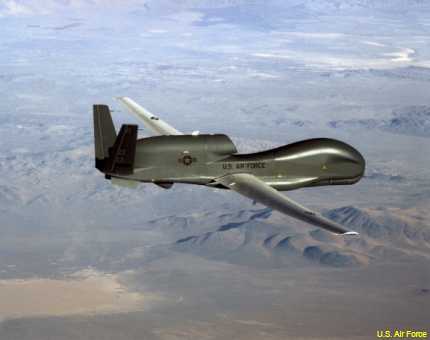Air Force to allow enlisted airmen to fly Global Hawks
In another effort to ameliorate the stress on remotely piloted aircraft crews, the service announced that enlisted personnel will be permitted to fly the surveillance-only aircraft.

Enlisted personnel will be able to fly the Global Hawk on ISR missions.
In a further move to ease the strain on increasingly taxed remotely piloted aircraft crews, the Air Force announced recently that enlisted personnel will be integrated into the fold.
However, enlisted soldiers will only pilot the unarmed, high-altitude, long-endurance RQ-4 Global Hawks surveillance aircraft. The Air Force is not considering measures to allow enlisted airmen to fly armed RPAs such as the MQ-1 Predator and MQ-9 Reaper, according to the Military Times. Previously, only officers could fly RPAs.
“What we learn from flying Global Hawks with enlisted pilots under the supervision of rated officers will inform whether we apply a similar approach to other weapon systems,” Gen. Mark A. Welsh III , chief of staff of the Air Force,said. “It is too soon to speculate on any expansion of enlisted aircrew beyond the Global Hawk program.”
“Our enlisted force is the best in the world and I am completely confident they will be able to do the job and do it well,” said Secretary of the Air Force Deborah Lee James. “The RPA enterprise is doing incredibly important work and this is the right decision to ensure the Air Force is positioned to support the future threat environment. Emerging requirements and combatant commander demands will only increase; therefore, we will position the service to provide warfighters and our nation the capability they deserve today and in the future.”
Over the next six months, the Air Force’s Air Combat Command, which overseas global combat flights of manned and unmanned aircraft, will develop an integration plan and entry requirements for enlisted soldiers as directed by James and the service’s chief of staff.
The service has been crippled by an increasing demand to provide intelligence, surveillance and reconnaissance for operations around the world taxing and overworking the pilots and crews of RPAs. “We’ve been in surges continuously for the last eight years – we went from 21 CAPs [combat air patrols] in 2008 to 65 CAPs,” Gen. Herbert "Hawk" Carlisle, commander of Air Force Air Combat Command, said in September, referring to the ability to provide 24-hour ISR coverage of a target area. “One of the challenges we’re having with respect to the RPA enterprise is we can’t get breathing room to do anything…We’re doing, unfortunately, zero continuation training because they’re all engaged in the fight.”
To address the problem the Air Force launched the Culture and Process Improvement Program aimed at fixing the issues associated with RPA pilots from a cultural standpoint. The results from the program were recently released calling, among other recommendations, for double the number of RPA squadrons, adding 2,500 to 3,500 airmen to man this increase, defining career tracks for RPA operators and crews – of both enlisted personnel and officers – and studying the selection process for promoting RPA officers. The force also announced retention bonuses for airmen of between $15,000 and $25,000.
James indicated during a town hall at Fort Meade in mid-December that the service needs more personnel for RPA.
Opening enlisted airmen to fly Global Hawks “will make the most of the capabilities of our superb enlisted force in order to increase agility in addressing the ISR needs of the warfighter,” James said in a statement. “Just as we integrated officer and enlisted crew positions in the space mission set, we will deliberately integrate enlisted pilots into the Global Hawk ISR community.”
“The Global Hawk mission is a strategically vital mission,” Welsh said. “The transition to enlisted pilots will be managed with minimum impact on current Global Hawk pilots. As always, we will continue to assess and balance our force to meet warfighter needs while ensuring appropriate force development.”
The Air Force said that this initiative is the first step toward developing future operating concepts within the multi-domain ISR enterprise. “The Global Hawk is the most stable RPA community and presents an ability to integrate new capabilities in an effort to better posture the force for the dynamic future operating environment,” the Air Force’s statement said.
The Global Hawk will likely play an increasingly important role in the future as the manned U-2 ISR aircraft will be retired. “The U-2 was decided upon as being retired and the Global Hawk going to pick up some of the –not all of – but some of the capabilities of the U-2,” said Lt. Col. Timothy McDonald, deputy of ISR Requirements at the Air Force’s Air Combat Command.